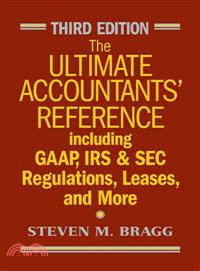The Ultimate Accountants' Reference ─ Including GAAP, IRS & Sec Regulations, Leases, and More
商品資訊
ISBN13:9780470572542
出版社:JOHN WILEY & SONS;LTD
作者:BRAGG
出版日:2010/02/02
裝訂/頁數:精裝/816頁
規格:25.4cm*17.8cm*3.8cm (高/寬/厚)
版次:3
定價
:NT$ 7370 元優惠價
:90 折 6633 元
若需訂購本書,請電洽客服 02-25006600[分機130、131]。
商品簡介
作者簡介
目次
相關商品
商品簡介
A wide-ranging source of information for the practicing accountant, The Ultimate Accountants' Reference, Third Edition covers accounting regulations for all aspects of financial statements, accounting management reports, and management of the accounting department, including best practices, control systems, and the fast close. It also addresses financing options, pension plans, and taxation options. The perfect daily answer book, accountants and accounting managers will turn to The Ultimate Accountants’ Reference, Third Edition time and again for answers to the largest possible number of accounting issues that are likely to arise.
作者簡介
Steven Bragg, CPA, (Centennial, CO), has been the chief financial officer or controller of four companies, as well as a consulting manager at Ernst & Young and auditor at Deloitte & Touche. He has published 34 books through John Wiley & Sons.
目次
About the Author.
Preface.
Part One: Overview of Accounting and Its Role in the Organization.
1 Introduction.
2 The Role of Accounting.
2.1 Tasks of the Accounting Function.
2.2 Role of the Accounting Function.
2.3 Impact of Ethics on the Accounting Role.
2.4 Accounting Job Descriptions.
2.5 Summary.
Part Two: Accounting Rules and Regulations.
3 Standard-Setting Organizations.
3.1 Introduction.
3.2 The Committee on Accounting Procedure.
3.3 The Accounting Principles Board.
3.4 The Financial Accounting Foundation.
3.5 The Financial Accounting Standards Board.
3.6 Public Company Accounting Oversight Board (PCAOB).
3.7 The Government Accounting Standards Board.
3.8 Accounting Standards Executive Committee (AcSEC).
3.9 The International Accounting Standards Board.
3.10 The Convergence of U.S. and International Accounting Rules.
3.11 Summary.
4 The Securities and Exchange Commission.
4.1 Introduction.
4.2 Overview of the SEC.
4.3 Organization of the SEC.
4.4 EDGAR.
4.5 The Securities Act of 1933.
4.6 The Securities Exchange Act of 1934.
4.7 The Public Utility Holding Company Act of 1935.
4.8 The Trust Indenture Act of 1939.
4.9 The Investment Company Act of 1940.
4.10 The Investment Advisers Act of 1940.
4.11 Regulation FD.
4.12 Regulation M-A.
4.13 Regulation S-K.
4.14 Regulation S-T.
4.15 Regulation S-X (Requirements for Financial Statement Reporting).
4.16 Staff Accounting Bulletins.
4.17 Staff Accounting Bulletin 99: Materiality.
4.18 Forms to be Filed with the SEC.
4.19 Summary.
5 Laws Impacting Accounting.
5.1 Introduction.
5.2 Ethics.
5.3 Employment Eligibility.
5.4 Garnishments.
5.5 Health Insurance.
5.6 Pensions.
5.7 Taxes.
5.8 Wages and Overtime.
5.9 Other Laws Impacting Accounting.
5.10 Summary.
Part Three: Accounting Reports.
6 The Balance Sheet and Statement of Stockholders' Equity.
6.1 Introduction.
6.2 Uses of the Balance Sheet and Statement of Stockholders' Equity.
6.3 The Balance Sheet Format.
6.4 Asset Definitions.
6.5 Liability Definitions.
6.6 Stockholders' Equity Definitions.
6.7 The Statement of Stockholders' Equity Format.
6.8 Accounting Treatment of Offsets to Assets and Liabilities.
6.9 Critique of the Balance Sheet.
6.10 Summary.
7 The Income Statement.
7.1 Introduction.
7.2 Format of the Income Statement.
7.3 Expenses Listed in the Cost of Goods Sold.
7.4 Reporting Earnings per Share.
7.5 Treatment of Gains and Losses.
7.6 Treatment of Accounting Changes.
7.7 Treatment of Discontinued Operations.
7.8 Treatment of Extraordinary Items.
7.9 Treatment of Other Comprehensive Income.
7.10 Treatment of Prior Period Adjustments.
7.11 Summary.
8 The Statement of Cash Flows.
8.1 Introduction.
8.2 Operating Activities.
8.3 Investing Activities.
8.4 Financing Activities.
8.5 The Format of the Statement of Cash Flows.
8.6 Exemptions from the Statement of Cash Flows.
8.7 Presentation of Consolidated Entities.
8.8 Treatment of Foreign Currency Transactions.
8.9 Summary.
9 Footnotes.
9.1 Introduction.
9.2 Disclosure of Accounting Changes.
9.3 Disclosure of Accounting Policies.
9.4 Disclosure of Asset Impairments.
9.5 Disclosure of Bad Debt Recognition.
9.6 Disclosure of Barter Revenue.
9.7 Disclosure of Bill and Hold Transactions.
9.8 Disclosure of Business Combinations.
9.9 Disclosure of Callable Obligations.
9.10 Disclosure of Capital Structure.
9.11 Disclosure of Cash Deposits in Excess of FDIC Insurance Limits.
9.12 Disclosure of Cash Restrictions.
9.13 Disclosure of Change in Reported Method of Investment.
9.14 Disclosure of Changes in Investment Fair Value after Balance Sheet Date.
9.15 Disclosure of Collateral.
9.16 Disclosure of Collective Bargaining Agreements.
9.17 Disclosure of Commitments.
9.18 Disclosure of Compensating Balances.
9.19 Disclosure of Consignment Revenue.
9.20 Disclosure of Contingent Asset Purchase Obligation.
9.21 Disclosure of Contingent Liabilities.
9.22 Disclosure of Continued Existence Doubts.
9.23 Disclosure of Contract Revenue Recognition.
9.24 Disclosure of Customers.
9.25 Disclosure of Derivative Use Objectives.
9.26 Disclosure of Discontinued Operations.
9.27 Disclosure of Dividends.
9.28 Disclosure of Earnings per Share.
9.29 Disclosure of Employee Stock Ownership Plan.
9.30 Disclosure of Employment Contract Liabilities.
9.31 Disclosure of Error Corrections.
9.32 Disclosure of Gain Contingencies.
9.33 Disclosure of Gain or Loss on an Asset Sale.
9.34 Disclosure of Geographic Risk.
9.35 Disclosure of Goodwill.
9.36 Disclosure of Income Taxes.
9.37 Disclosure of Increase in Value of a Written-down Held-to-Maturity Investment.
9.38 Disclosure of Industry Risk.
9.39 Disclosure of Installment Sales.
9.40 Disclosure of Intangibles.
9.41 Disclosure of Inventory.
9.42 Disclosure of Investment Restrictions.
9.43 Disclosure of Investments.
9.44 Disclosure of Lease Termination Costs.
9.45 Disclosure of Leases by Lessees.
9.46 Disclosure of Life Insurance Proceeds.
9.47 Disclosure of Litigation.
9.48 Disclosure of Loan Acceleration.
9.49 Disclosure of Loan Extinguishment.
9.50 Disclosure of Loan Guarantees.
9.51 Disclosure of Loan Restructuring.
9.52 Disclosure of Loans.
9.53 Disclosure of Nonstandard Reported Method of Investment.
9.54 Disclosure of Par Value Change.
9.55 Disclosure of Postemployment Benefits.
9.56 Disclosure of Prior Period Adjustments.
9.57 Disclosure of Purchasing Commitments.
9.58 Disclosure of Reduction in Equity Method Investment.
9.59 Disclosure of Reduction in the Market Value of Equity Investments.
9.60 Disclosure of Related-Party Loans.
9.61 Disclosure of Revenue Recognition Policy.
9.62 Disclosure of Royalty Payments.
9.63 Disclosure of the Sale of Held-to-Maturity Investments.
9.64 Disclosure of Sales Return Allowance.
9.65 Disclosure of Sales with Significant Rights of Return.
9.66 Disclosure of Segment Information.
9.67 Disclosure of Shifts between Securities Accounts.
9.68 Disclosure of Significant Risks.
9.69 Disclosure of Stock Compensation.
9.70 Disclosure of Stock Options.
9.71 Disclosure of a Stock Repurchase Program.
9.72 Disclosure of a Stock Sale.
9.73 Disclosure of Stock Splits.
9.74 Disclosure of Stock Subscriptions.
9.75 Disclosure of Subsequent Events.
9.76 Disclosure of Taxation Disputes.
9.77 Disclosure of Unused Credit Facilities.
9.78 Disclosure of Warrants Issued.
9.79 Disclosure of Warranty Expense Allowance.
9.80 Disclosure of Warranty Revenue Recognition.
9.81 Summary.
10 Internal Management Reports.
10.1 Introduction.
10.2 Status Reports.
10.3 Margin Reports.
10.4 Cash Reports.
10.5 Sales and Expense Reports.
10.6 Payroll Reports.
10.7 Graphical Report Layouts.
10.8 Summary.
11 Foreign Currency Translation.
11.1 Introduction.
11.2 The Current Rate Translation Method.
11.3 Example of the Current Rate Method.
11.4 The Remeasurement Method.
11.5 Example of the Remeasurement Method.
11.6 Decision Tree.
11.7 Translation of Foreign Currency Transactions.
11.8 Exchange Rates Used for Calculations.
11.9 Intercompany Transactions.
11.10 Summary.
Part Four: Elements of the Balance Sheet and Income Statement.
12 Cash, Prepaid Expenses, and Investments.
12.1 Introduction.
12.2 Cash.
12.3 Prepaid Expenses.
12.4 Accounting for Marketable Equity Securities.
12.5 Transfers between Available-for-Sale and Trading Investments.
12.6 Accounting for Investments in Debt Securities.
12.7 Transfers of Debt Securities among Portfolios.
12.8 Accounting for Gains or Losses on Securities.
12.9 Recognition of Deferred Tax Effects on Changes in Investment Valuations.
12.10 The Equity Method of Investment Accounting.
12.11 Summary.
13 Inventory.
13.1 Introduction.
13.2 Types of Inventory.
13.3 The Inventory Tracking System.
13.4 The Physical Inventory Procedure.
13.5 Inventory Management.
13.6 Inventory Purchasing.
13.7 Inventory Receiving.
13.8 Inventory Storage.
13.9 Production Issues Impacting Inventory.
13.10 The Bill of Materials.
13.11 Product Design.
13.12 Customer Service.
13.13 Inventory Disposition.
13.14 Goods in Transit.
13.15 Accounting for Inventories.
13.16 Overhead Costs Allocable to Inventory.
13.17 Lower of Cost or Market Rule.
13.18 Specific Identification Inventory Valuation Method.
13.19 First-In, First-Out (FIFO) Inventory Valuation Method.
13.20 Last-in, First-out (LIFO) Inventory Valuation Method.
13.21 Dollar Value LIFO Inventory Valuation Method.
13.22 Link Chain Method.
13.23 Weighted-Average Inventory Valuation Method.
13.24 Type of Inventory Valuation System to Use.
13.25 Summary.
14 Accounts Receivable.
14.1 Introduction.
14.2 Definition of Accounts Receivable.
14.3 The Accounts Receivable Transaction Flow.
14.4 Credit Card Accounts Receivable.
14.5 Collateral, Assignments, and Factoring.
14.6 Sales Returns.
14.7 Early Payment Discounts.
14.8 Reporting of Long-Term Receivables.
14.9 Treatment of Bad Debts.
14.10 Receivables Ownership Decision.
14.11 Summary.
15 Fixed Assets.
15.1 Introduction.
15.2 The Capitalization Limit.
15.3 Fixed Asset Purchases.
15.4 Fixed Asset Improvements.
15.5 Capitalization of Interest.
15.6 Fixed Asset Dispositions.
15.7 Inbound Fixed Asset Donations.
15.8 Outbound Fixed Asset Donations.
15.9 Construction in Progress.
15.10 Accounting for Land.
15.11 Accounting for Leasehold Improvements.
15.12 The Depreciation Base.
15.13 Depreciation Issues.
15.14 Straight-Line Depreciation.
15.15 Double Declining Balance Depreciation.
15.16 Sum of the Years Digits Depreciation.
15.17 Units of Production Depreciation Method.
15.18 Asset Impairment.
15.19 Intangible Assets.
15.20 The Asset Acquisition Capitalization or Expense Decision.
15.21 Summary.
16 Current Liabilities and Contingencies.
16.1 Introduction.
16.2 The Accounts Payable Transaction Flow.
16.3 Accounting for the Period-End Cutoff.
16.4 Current Liabilities-Presentation.
16.5 Current Liabilities-Advances.
16.6 Current Liabilities-Bonuses.
16.7 Current Liabilities-Commissions.
16.8 Current Liabilities-Compensated Absences.
16.9 Current Liabilities-Debt.
16.10 Current Liabilities-Employee Terminations.
16.11 Current Liabilities-Property Taxes.
16.12 Current Liabilities-Royalties.
16.13 Current Liabilities-Wages.
16.14 Current Liabilities-Warranty Claims.
16.15 Contingencies.
16.16 Contingencies-Debt Covenant Violation.
16.17 Contingencies-Debt Guarantees.
16.18 Contingencies-Guaranteed Minimum Option Price.
16.19 Summary.
17 Debt.
17.1 Introduction.
17.2 Overview of Bonds.
17.3 Debt Classification.
17.4 Interest Risk Management.
17.5 Bonds Sold at a Discount or Premium to Their Face Value.
17.6 Effective Interest Method.
17.7 Debt Issued with No Stated Interest Rate.
17.8 Debt Issuance Costs.
17.9 Notes Issued with Attached Rights.
17.10 Notes Issued for Property.
17.11 Extinguishment of Debt.
17.12 Scheduled Bond Retirement.
17.13 Convertible Debt.
17.14 Convertible Debt Issued in the Money.
17.15 Convertible Debt-Accrued but Unpaid Interest on Converted Debt.
17.16 Convertible Debt-Subsequent Change in Offering to Induce Conversion.
17.17 Debt Issued with Stock Warrants.
17.18 Accounting for Interest Risk Management Activities.
17.19 Decision Points during the Lifetime of a Bond.
17.20 Summary.
18 Equity.
18.1 Introduction.
18.2 Legal Capital and Capital Stock.
18.3 Convertible Preferred Stock.
18.4 Stock Splits.
18.5 Stock Subscriptions.
18.6 Retained Earnings.
18.7 Stock Warrants.
18.8 Dividends.
18.9 Treasury Stock.
18.10 Stock Appreciation Rights.
18.11 Employee Stock Ownership Plans.
18.12 Summary.
19 Stock Options.
19.1 Introduction.
19.2 Option Accounting.
19.3 Compensation Expense Recognition.
19.4 Options-Measurement Using SFAS 123 Requirements.
19.5 Stock Option Recordkeeping.
19.6 Summary.
20 Revenue.
20.1 Introduction.
20.2 Revenue Recognition Concepts.
20.3 Revenue Recognition Scenarios.
20.4 Bill and Hold Revenue Transactions.
20.5 Recording Revenues at Gross or Net.
20.6 Reducing Revenue by Cash Paid to Customers.
20.7 Long-Term Construction Contracts.
20.8 Service Revenues.
20.9 Recognition of Losses on Service Contracts.
20.10 Recording Initiation Fees as Service Revenue.
20.11 Recording Out-of-Pocket Expense Reimbursements.
20.12 Sales When Collection Is Uncertain.
20.13 Repossession of Goods under Installment Sales.
20.14 Revenue Recognition When Right of Return Exists.
20.15 Revenue Recognition for Accretion and Appreciation.
20.16 Summary.
21 Research and Development.
21.1 Introduction.
21.2 Definition of Research and Development.
21.3 Accounting for In-House R&D Costs.
21.4 Accounting for Acquired R&D Costs.
21.5 Accounting for R&D Costs Contracted to Another Party.
21.6 R&D Costs in the Software Industry.
21.7 Summary.
22 Leases.
22.1 Introduction.
22.2 Accounting for Leases-Lessee.
22.3 Accounting for Leases-Lessor.
22.4 Accounting for Operating Leases-Lessor.
22.5 Accounting for Sales-Type Leases-Lessor.
22.6 Accounting for Direct Financing Leases-Lessor.
22.7 Lease Terminations.
22.8 Lease Extensions.
22.9 Subleases.
22.10 Sale-Leaseback Transactions.
22.11 Summary.
23 Earnings per Share.
23.1 Introduction.
23.2 Earnings per Share Presentation Requirements.
23.3 Earnings per Share for a Simple Capital Structure.
23.4 Diluted Earnings per Share.
23.5 Treasury Stock Method.
23.6 If-Converted Method.
23.7 Earnings per Share Disclosures.
23.8 Summary.
24 Segment Reporting.
24.1 Introduction.
24.2 Segment Reporting Requirements.
24.3 Testing for Reportable Segments.
24.4 Segment Aggregation.
24.5 Cost and Asset Allocation Issues.
24.6 Segment-Related Disclosures.
24.7 Summary.
25 Interim Reporting.
25.1 Introduction.
25.2 Requirements for Interim Reporting.
25.3 Interim Reporting Guidelines.
25.4 Interim-Period Disclosures.
25.5 Summary.
26 Accounting Changes and Correction of Errors.
26.1 Introduction.
26.2 Definitions.
26.3 Changes in Accounting Principle.
26.4 Changes in Accounting Estimate.
26.5 Changes in Reporting Entity.
26.6 Correction of Errors.
26.7 Disclosure of Accounting Changes and Correction of Errors.
26.8 Summary.
Part Five: Accounting Management.
27 Best Practices.
27.1 Introduction.
27.2 Best Practices.
27.3 Best Practices Process Flowcharts.
27.4 Summary.
28 Budgeting.
28.1 Introduction.
28.2 The System of Interlocking Budgets.
28.3 A Sample Budget.
28.4 The Flex Budget.
28.5 Capital Budgeting-Traditional Method.
28.6 The Budgeting Process.
28.7 Budgetary Control Systems.
28.8 Summary.
29 Closing the Books.
29.1 Introduction.
29.2 The Current State of the Financial Statements.
29.3 Interim Reports.
29.4 General Improvements for Closing the Books.
29.5 Closing Activities Prior to Period-End.
29.6 Closing Activities Subsequent to Period-End.
29.7 Closing Activities Subsequent to Statement Issuance.
29.8 The Closing Checklist.
29.9 Results of Closing Improvements.
29.10 The Instantaneous Close.
29.11 Closing the Books of a Public Company.
29.12 Summary.
30 Control Systems.
30.1 Introduction.
30.2 The Need for Control Systems.
30.3 Types of Fraud.
30.4 Order Entry and Credit Controls.
30.5 Inventory Controls.
30.6 Accounts Payable Controls.
30.7 Billing Controls.
30.8 Cash Receipts Controls.
30.9 Payroll Controls.
30.10 Closing Controls.
30.11 Key Controls.
30.12 When to Eliminate Controls.
30.13 Summary.
31 Cost Accounting.
31.1 Introduction.
31.2 The Purpose of Cost Accounting Information.
31.3 Input: Data Collection Systems.
31.4 Processing: Data Summarization Systems.
31.5 Processing: Job Costing.
31.6 Processing: Process Costing.
31.7 Processing: Standard Costing.
31.8 Processing: Direct Costing.
31.9 Processing: Throughput Costing.
31.10 Processing: Activity-Based Costing.
31.11 Processing: Target Costing.
31.12 Processing: By-Product and Joint Product Costing.
31.13 Outputs: Cost Variances.
31.14 Summary.
32 Financial Analysis.
32.1 Introduction.
32.2 The Cost of Capital.
32.3 Breakeven Analysis.
32.4 Eliminating Unprofitable Products.
32.5 Risk Analysis.
32.6 Business Cycle Forecasting.
32.7 Summary.
33 Records Management.
33.1 Introduction.
33.2 RecordKeeping Costs.
33.3 Recordkeeping Policies and Procedures.
33.4 Required Tax Records.
33.5 Summary.
Part Six: Financial Management.
34 Customer Credit.
34.1 Introduction.
34.2 Types of Credit.
34.3 Selling Terms.
34.4 Credit Examination.
34.5 Collection Techniques.
34.6 Summary.
35 Financing.
35.1 Introduction.
35.2 Management of Financing Issues.
35.3 Bank Relations.
35.4 Accounts Payable Payment Delay.
35.5 Accounts Receivable Collection Acceleration.
35.6 Credit Cards.
35.7 Employee Tradeoffs.
35.8 Equity.
35.9 Factoring.
35.10 Field Warehouse Financing.
35.11 Floor Planning.
35.12 Inventory Reduction.
35.13 Lease.
35.14 Lease, Synthetic.
35.15 Line of Credit.
35.16 Loan, Asset-Based.
35.17 Loan, Bond.
35.18 Loan, Bridge.
35.19 Loan, Economic Development Authority.
35.20 Loan, Long-Term.
35.21 Loan, Short-Term.
35.22 Private Investment in Public Equity.
35.23 Preferred Stock.
35.24 Sale and Leaseback.
35.25 Summary.
36 Cash Management.
36.1 Introduction.
36.2 The Cash Forecasting Model.
36.3 Measuring Cash Forecast Accuracy.
36.4 Cash Forecasting Automation.
36.5 Cash Management Controls.
36.6 The Benefits of Cash Concentration.
36.7 Cash Concentration Strategies.
36.8 Pooling Concepts.
36.9 Physical Sweeping.
36.10 Notional Pooling.
36.11 Investment Criteria.
36.12 Investment Options.
36.13 Investment Strategies.
36.14 Risk Reduction Strategies.
36.15 Summary.
37 Foreign Exchange Management.
37.1 Introduction.
37.2 Foreign Exchange Quote Terminology.
37.3 The Nature of Foreign Exchange Risk.
37.4 Data Collection for Foreign Exchange Risk Management.
37.5 Foreign Exchange Hedging Strategies.
37.6 Hedge Accounting.
37.7 Foreign Exchange Hedge Controls.
37.8 Foreign Exchange Hedge Policies.
37.9 Recordkeeping for Foreign Exchange Hedging Activities.
37.10 Summary.
38 Risk Management.
38.1 Introduction.
38.2 Risk Management Policies.
38.3 Manager of Risk Management.
38.4 Risk Management Procedures.
38.5 Types of Insurance Companies.
38.6 Claims Administration.
38.7 Insurance Files.
38.8 Annual Risk Management Report.
38.9 Summary.
Part Seven: Other Accounting Topics.
39 Mergers and Acquisitions.
39.1 Introduction.
39.2 Evaluating Acquisition Targets.
39.3 Valuing an Acquisition Target.
39.4 Types of Acquisitions.
39.5 The Purchase Method.
39.6 The Cost Method.
39.7 The Equity Method.
39.8 The Consolidation Method.
39.9 Push-Down Accounting.
39.10 Leveraged Buyouts.
39.11 Spin-Off Transactions.
39.12 Summary.
40 The Initial Public Offering.
40.1 Introduction.
40.2 Reasons to Go Public.
40.3 Reasons Not to Go Public.
40.4 The Cost of an IPO.
40.5 Preparing for the IPO.
40.6 Finding an Underwriter.
40.7 Registering for and Completing the IPO.
40.8 Alternatives for Selling Securities.
40.9 Listing on an Exchange.
40.10 Restrictions on Stock in a Publicly Traded Company.
40.11 Summary.
41 Going Private.
41.1 Introduction.
41.2 The Going-Private Transaction.
41.3 Rule 13E-3.
41.4 Shareholder Count Manipulation.
41.5 Filling Out Schedule 13E-3.
41.6 Form 15.
41.7 Summary.
42 Bankruptcy.
42.1 Introduction.
42.2 Applicable Bankruptcy Laws.
42.3 Players in the Bankruptcy Drama.
42.4 Creditor and Shareholder Payment Priorities.
42.5 The Bankruptcy Sequence of Events.
42.6 Tax Liabilities in a Bankruptcy.
42.7 Special Bankruptcy Rules.
42.8 Alternatives to Bankruptcy.
42.9 Summary.
43 Taxation.
43.1 Introduction.
43.2 The Strategy of Tax Planning.
43.3 Accumulated Earnings Tax.
43.4 Alternative Minimum Tax.
43.5 Barter.
43.6 Bonuses and Awards.
43.7 Cash Method of Accounting.
43.8 Change of Accounting Method.
43.9 Change of Tax Year.
43.10 Club Dues.
43.11 Consignment Revenue.
43.12 Deferred Compensation.
43.13 Depreciation.
43.14 Distributions.
43.15 Estimated Taxes.
43.16 Financial Reporting of Tax Liabilities.
43.17 Foreign Earned Income.
43.18 Gifts (Business).
43.19 Goodwill and Other Intangibles.
43.20 Hybrid Methods of Accounting.
43.21 Imputed Interest Expense.
43.22 Installment Sales.
43.23 Inventory Valuation.
43.24 Life Insurance.
43.25 Like-Kind Exchanges.
43.26 Losses.
43.27 Nexus.
43.28 Organizational Expenses.
43.29 Partnership Taxation.
43.30 Passive Activity Losses.
43.31 Property Taxes.
43.32 Retirement Plans.
43.33 S Corporations.
43.34 Sales and Use Taxes.
43.35 Sales Returns/Bad Debts.
43.36 Social Security Tax.
43.37 Stock Appreciation Rights.
43.38 Stock Options.
43.39 Tax Rate, Corporate.
43.40 Tax Year.
43.41 Transfer Pricing.
43.42 Unemployment Taxes.
43.43 Warranty Expenses.
43.44 Summary.
A The Chart of Accounts.
A.1 Three-Digit Account Code Structure.
A.2 Five-Digit Account Code Structure.
A.3 Seven-Digit Account Code Structure.
B Journal Entries.
B.1 Acquisitions.
B.2 Bill and Hold Transactions.
B.3 Bank Reconciliation.
B.4 Current Liabilities.
B.5 Debt, Convertible.
B.6 Debt Extinguishment.
B.7 Debt Issued with Stock Warrants.
B.8 Debt Security Transfers Among Portfolios.
B.9 Dividends.
B.10 Effective Interest Method.
B.11 Employee Stock Ownership Plan (ESOP).
B.12 Equity Method of Accounting for Investments.
B.13 Equity Security Transfers between Available-for-Sale and Trading Portfolios.
B.14 Fixed Assets.
B.15 Foreign Currency.
B.16 Intangible Assets.
B.17 Inventory Adjustments.
B.18 Inventory in Transit.
B.19 Inventory Valuation.
B.20 Investments in Debt Securities.
B.21 Leases-Lessee Accounting.
B.22 Leases-Lessor Accounting.
B.23 Long-Term Construction Contracts.
B.24 Marketable Equity Securities.
B.25 Notes and Bonds.
B.26 Options.
B.27 Pensions.
B.28 Receivables.
B.29 Revenue Recognition When Right of Return Exists.
B.30 Revenue, Installment.
B.31 Revenue, Service.
B.32 Sale-Leaseback Transactions.
B.33 Stock.
B.34 Stock Appreciation Rights (SAR).
B.35 Stock Subscriptions.
B.36 Taxes.
B.37 Treasury Stock.
B.38 Warrants.
C Interest Tables.
C.1 Simple Interest Table.
C.2 Compound Interest (Future Amount of 1 at Compound Interest Due in N Periods).
C.3 Compound Interest (Present Value of 1 Due in N Periods).
C.4 Present Value of Ordinary Annuity of 1 per Period.
C.5 Future Amount of Ordinary Annuity of 1 per Period.
D Ratios.
E Due Diligence Checklist.
E.1 Industry Overview.
E.2 Corporate Overview.
E.3 Organization and General Corporate Issues.
E.4 Capitalization and Significant Subsidiaries.
E.5 Cultural Issues-General.
E.6 Cultural Issues-Management.
E.7 Employees.
E.8 Revenue.
E.9 Assets.
E.10 Liabilities.
E.11 Financial Statements.
E.12 Internet.
E.13 Software Development.
E.14 Product Development.
E.15 Marketing.
E.16 Sales.
E.17 Other.
Index.
Preface.
Part One: Overview of Accounting and Its Role in the Organization.
1 Introduction.
2 The Role of Accounting.
2.1 Tasks of the Accounting Function.
2.2 Role of the Accounting Function.
2.3 Impact of Ethics on the Accounting Role.
2.4 Accounting Job Descriptions.
2.5 Summary.
Part Two: Accounting Rules and Regulations.
3 Standard-Setting Organizations.
3.1 Introduction.
3.2 The Committee on Accounting Procedure.
3.3 The Accounting Principles Board.
3.4 The Financial Accounting Foundation.
3.5 The Financial Accounting Standards Board.
3.6 Public Company Accounting Oversight Board (PCAOB).
3.7 The Government Accounting Standards Board.
3.8 Accounting Standards Executive Committee (AcSEC).
3.9 The International Accounting Standards Board.
3.10 The Convergence of U.S. and International Accounting Rules.
3.11 Summary.
4 The Securities and Exchange Commission.
4.1 Introduction.
4.2 Overview of the SEC.
4.3 Organization of the SEC.
4.4 EDGAR.
4.5 The Securities Act of 1933.
4.6 The Securities Exchange Act of 1934.
4.7 The Public Utility Holding Company Act of 1935.
4.8 The Trust Indenture Act of 1939.
4.9 The Investment Company Act of 1940.
4.10 The Investment Advisers Act of 1940.
4.11 Regulation FD.
4.12 Regulation M-A.
4.13 Regulation S-K.
4.14 Regulation S-T.
4.15 Regulation S-X (Requirements for Financial Statement Reporting).
4.16 Staff Accounting Bulletins.
4.17 Staff Accounting Bulletin 99: Materiality.
4.18 Forms to be Filed with the SEC.
4.19 Summary.
5 Laws Impacting Accounting.
5.1 Introduction.
5.2 Ethics.
5.3 Employment Eligibility.
5.4 Garnishments.
5.5 Health Insurance.
5.6 Pensions.
5.7 Taxes.
5.8 Wages and Overtime.
5.9 Other Laws Impacting Accounting.
5.10 Summary.
Part Three: Accounting Reports.
6 The Balance Sheet and Statement of Stockholders' Equity.
6.1 Introduction.
6.2 Uses of the Balance Sheet and Statement of Stockholders' Equity.
6.3 The Balance Sheet Format.
6.4 Asset Definitions.
6.5 Liability Definitions.
6.6 Stockholders' Equity Definitions.
6.7 The Statement of Stockholders' Equity Format.
6.8 Accounting Treatment of Offsets to Assets and Liabilities.
6.9 Critique of the Balance Sheet.
6.10 Summary.
7 The Income Statement.
7.1 Introduction.
7.2 Format of the Income Statement.
7.3 Expenses Listed in the Cost of Goods Sold.
7.4 Reporting Earnings per Share.
7.5 Treatment of Gains and Losses.
7.6 Treatment of Accounting Changes.
7.7 Treatment of Discontinued Operations.
7.8 Treatment of Extraordinary Items.
7.9 Treatment of Other Comprehensive Income.
7.10 Treatment of Prior Period Adjustments.
7.11 Summary.
8 The Statement of Cash Flows.
8.1 Introduction.
8.2 Operating Activities.
8.3 Investing Activities.
8.4 Financing Activities.
8.5 The Format of the Statement of Cash Flows.
8.6 Exemptions from the Statement of Cash Flows.
8.7 Presentation of Consolidated Entities.
8.8 Treatment of Foreign Currency Transactions.
8.9 Summary.
9 Footnotes.
9.1 Introduction.
9.2 Disclosure of Accounting Changes.
9.3 Disclosure of Accounting Policies.
9.4 Disclosure of Asset Impairments.
9.5 Disclosure of Bad Debt Recognition.
9.6 Disclosure of Barter Revenue.
9.7 Disclosure of Bill and Hold Transactions.
9.8 Disclosure of Business Combinations.
9.9 Disclosure of Callable Obligations.
9.10 Disclosure of Capital Structure.
9.11 Disclosure of Cash Deposits in Excess of FDIC Insurance Limits.
9.12 Disclosure of Cash Restrictions.
9.13 Disclosure of Change in Reported Method of Investment.
9.14 Disclosure of Changes in Investment Fair Value after Balance Sheet Date.
9.15 Disclosure of Collateral.
9.16 Disclosure of Collective Bargaining Agreements.
9.17 Disclosure of Commitments.
9.18 Disclosure of Compensating Balances.
9.19 Disclosure of Consignment Revenue.
9.20 Disclosure of Contingent Asset Purchase Obligation.
9.21 Disclosure of Contingent Liabilities.
9.22 Disclosure of Continued Existence Doubts.
9.23 Disclosure of Contract Revenue Recognition.
9.24 Disclosure of Customers.
9.25 Disclosure of Derivative Use Objectives.
9.26 Disclosure of Discontinued Operations.
9.27 Disclosure of Dividends.
9.28 Disclosure of Earnings per Share.
9.29 Disclosure of Employee Stock Ownership Plan.
9.30 Disclosure of Employment Contract Liabilities.
9.31 Disclosure of Error Corrections.
9.32 Disclosure of Gain Contingencies.
9.33 Disclosure of Gain or Loss on an Asset Sale.
9.34 Disclosure of Geographic Risk.
9.35 Disclosure of Goodwill.
9.36 Disclosure of Income Taxes.
9.37 Disclosure of Increase in Value of a Written-down Held-to-Maturity Investment.
9.38 Disclosure of Industry Risk.
9.39 Disclosure of Installment Sales.
9.40 Disclosure of Intangibles.
9.41 Disclosure of Inventory.
9.42 Disclosure of Investment Restrictions.
9.43 Disclosure of Investments.
9.44 Disclosure of Lease Termination Costs.
9.45 Disclosure of Leases by Lessees.
9.46 Disclosure of Life Insurance Proceeds.
9.47 Disclosure of Litigation.
9.48 Disclosure of Loan Acceleration.
9.49 Disclosure of Loan Extinguishment.
9.50 Disclosure of Loan Guarantees.
9.51 Disclosure of Loan Restructuring.
9.52 Disclosure of Loans.
9.53 Disclosure of Nonstandard Reported Method of Investment.
9.54 Disclosure of Par Value Change.
9.55 Disclosure of Postemployment Benefits.
9.56 Disclosure of Prior Period Adjustments.
9.57 Disclosure of Purchasing Commitments.
9.58 Disclosure of Reduction in Equity Method Investment.
9.59 Disclosure of Reduction in the Market Value of Equity Investments.
9.60 Disclosure of Related-Party Loans.
9.61 Disclosure of Revenue Recognition Policy.
9.62 Disclosure of Royalty Payments.
9.63 Disclosure of the Sale of Held-to-Maturity Investments.
9.64 Disclosure of Sales Return Allowance.
9.65 Disclosure of Sales with Significant Rights of Return.
9.66 Disclosure of Segment Information.
9.67 Disclosure of Shifts between Securities Accounts.
9.68 Disclosure of Significant Risks.
9.69 Disclosure of Stock Compensation.
9.70 Disclosure of Stock Options.
9.71 Disclosure of a Stock Repurchase Program.
9.72 Disclosure of a Stock Sale.
9.73 Disclosure of Stock Splits.
9.74 Disclosure of Stock Subscriptions.
9.75 Disclosure of Subsequent Events.
9.76 Disclosure of Taxation Disputes.
9.77 Disclosure of Unused Credit Facilities.
9.78 Disclosure of Warrants Issued.
9.79 Disclosure of Warranty Expense Allowance.
9.80 Disclosure of Warranty Revenue Recognition.
9.81 Summary.
10 Internal Management Reports.
10.1 Introduction.
10.2 Status Reports.
10.3 Margin Reports.
10.4 Cash Reports.
10.5 Sales and Expense Reports.
10.6 Payroll Reports.
10.7 Graphical Report Layouts.
10.8 Summary.
11 Foreign Currency Translation.
11.1 Introduction.
11.2 The Current Rate Translation Method.
11.3 Example of the Current Rate Method.
11.4 The Remeasurement Method.
11.5 Example of the Remeasurement Method.
11.6 Decision Tree.
11.7 Translation of Foreign Currency Transactions.
11.8 Exchange Rates Used for Calculations.
11.9 Intercompany Transactions.
11.10 Summary.
Part Four: Elements of the Balance Sheet and Income Statement.
12 Cash, Prepaid Expenses, and Investments.
12.1 Introduction.
12.2 Cash.
12.3 Prepaid Expenses.
12.4 Accounting for Marketable Equity Securities.
12.5 Transfers between Available-for-Sale and Trading Investments.
12.6 Accounting for Investments in Debt Securities.
12.7 Transfers of Debt Securities among Portfolios.
12.8 Accounting for Gains or Losses on Securities.
12.9 Recognition of Deferred Tax Effects on Changes in Investment Valuations.
12.10 The Equity Method of Investment Accounting.
12.11 Summary.
13 Inventory.
13.1 Introduction.
13.2 Types of Inventory.
13.3 The Inventory Tracking System.
13.4 The Physical Inventory Procedure.
13.5 Inventory Management.
13.6 Inventory Purchasing.
13.7 Inventory Receiving.
13.8 Inventory Storage.
13.9 Production Issues Impacting Inventory.
13.10 The Bill of Materials.
13.11 Product Design.
13.12 Customer Service.
13.13 Inventory Disposition.
13.14 Goods in Transit.
13.15 Accounting for Inventories.
13.16 Overhead Costs Allocable to Inventory.
13.17 Lower of Cost or Market Rule.
13.18 Specific Identification Inventory Valuation Method.
13.19 First-In, First-Out (FIFO) Inventory Valuation Method.
13.20 Last-in, First-out (LIFO) Inventory Valuation Method.
13.21 Dollar Value LIFO Inventory Valuation Method.
13.22 Link Chain Method.
13.23 Weighted-Average Inventory Valuation Method.
13.24 Type of Inventory Valuation System to Use.
13.25 Summary.
14 Accounts Receivable.
14.1 Introduction.
14.2 Definition of Accounts Receivable.
14.3 The Accounts Receivable Transaction Flow.
14.4 Credit Card Accounts Receivable.
14.5 Collateral, Assignments, and Factoring.
14.6 Sales Returns.
14.7 Early Payment Discounts.
14.8 Reporting of Long-Term Receivables.
14.9 Treatment of Bad Debts.
14.10 Receivables Ownership Decision.
14.11 Summary.
15 Fixed Assets.
15.1 Introduction.
15.2 The Capitalization Limit.
15.3 Fixed Asset Purchases.
15.4 Fixed Asset Improvements.
15.5 Capitalization of Interest.
15.6 Fixed Asset Dispositions.
15.7 Inbound Fixed Asset Donations.
15.8 Outbound Fixed Asset Donations.
15.9 Construction in Progress.
15.10 Accounting for Land.
15.11 Accounting for Leasehold Improvements.
15.12 The Depreciation Base.
15.13 Depreciation Issues.
15.14 Straight-Line Depreciation.
15.15 Double Declining Balance Depreciation.
15.16 Sum of the Years Digits Depreciation.
15.17 Units of Production Depreciation Method.
15.18 Asset Impairment.
15.19 Intangible Assets.
15.20 The Asset Acquisition Capitalization or Expense Decision.
15.21 Summary.
16 Current Liabilities and Contingencies.
16.1 Introduction.
16.2 The Accounts Payable Transaction Flow.
16.3 Accounting for the Period-End Cutoff.
16.4 Current Liabilities-Presentation.
16.5 Current Liabilities-Advances.
16.6 Current Liabilities-Bonuses.
16.7 Current Liabilities-Commissions.
16.8 Current Liabilities-Compensated Absences.
16.9 Current Liabilities-Debt.
16.10 Current Liabilities-Employee Terminations.
16.11 Current Liabilities-Property Taxes.
16.12 Current Liabilities-Royalties.
16.13 Current Liabilities-Wages.
16.14 Current Liabilities-Warranty Claims.
16.15 Contingencies.
16.16 Contingencies-Debt Covenant Violation.
16.17 Contingencies-Debt Guarantees.
16.18 Contingencies-Guaranteed Minimum Option Price.
16.19 Summary.
17 Debt.
17.1 Introduction.
17.2 Overview of Bonds.
17.3 Debt Classification.
17.4 Interest Risk Management.
17.5 Bonds Sold at a Discount or Premium to Their Face Value.
17.6 Effective Interest Method.
17.7 Debt Issued with No Stated Interest Rate.
17.8 Debt Issuance Costs.
17.9 Notes Issued with Attached Rights.
17.10 Notes Issued for Property.
17.11 Extinguishment of Debt.
17.12 Scheduled Bond Retirement.
17.13 Convertible Debt.
17.14 Convertible Debt Issued in the Money.
17.15 Convertible Debt-Accrued but Unpaid Interest on Converted Debt.
17.16 Convertible Debt-Subsequent Change in Offering to Induce Conversion.
17.17 Debt Issued with Stock Warrants.
17.18 Accounting for Interest Risk Management Activities.
17.19 Decision Points during the Lifetime of a Bond.
17.20 Summary.
18 Equity.
18.1 Introduction.
18.2 Legal Capital and Capital Stock.
18.3 Convertible Preferred Stock.
18.4 Stock Splits.
18.5 Stock Subscriptions.
18.6 Retained Earnings.
18.7 Stock Warrants.
18.8 Dividends.
18.9 Treasury Stock.
18.10 Stock Appreciation Rights.
18.11 Employee Stock Ownership Plans.
18.12 Summary.
19 Stock Options.
19.1 Introduction.
19.2 Option Accounting.
19.3 Compensation Expense Recognition.
19.4 Options-Measurement Using SFAS 123 Requirements.
19.5 Stock Option Recordkeeping.
19.6 Summary.
20 Revenue.
20.1 Introduction.
20.2 Revenue Recognition Concepts.
20.3 Revenue Recognition Scenarios.
20.4 Bill and Hold Revenue Transactions.
20.5 Recording Revenues at Gross or Net.
20.6 Reducing Revenue by Cash Paid to Customers.
20.7 Long-Term Construction Contracts.
20.8 Service Revenues.
20.9 Recognition of Losses on Service Contracts.
20.10 Recording Initiation Fees as Service Revenue.
20.11 Recording Out-of-Pocket Expense Reimbursements.
20.12 Sales When Collection Is Uncertain.
20.13 Repossession of Goods under Installment Sales.
20.14 Revenue Recognition When Right of Return Exists.
20.15 Revenue Recognition for Accretion and Appreciation.
20.16 Summary.
21 Research and Development.
21.1 Introduction.
21.2 Definition of Research and Development.
21.3 Accounting for In-House R&D Costs.
21.4 Accounting for Acquired R&D Costs.
21.5 Accounting for R&D Costs Contracted to Another Party.
21.6 R&D Costs in the Software Industry.
21.7 Summary.
22 Leases.
22.1 Introduction.
22.2 Accounting for Leases-Lessee.
22.3 Accounting for Leases-Lessor.
22.4 Accounting for Operating Leases-Lessor.
22.5 Accounting for Sales-Type Leases-Lessor.
22.6 Accounting for Direct Financing Leases-Lessor.
22.7 Lease Terminations.
22.8 Lease Extensions.
22.9 Subleases.
22.10 Sale-Leaseback Transactions.
22.11 Summary.
23 Earnings per Share.
23.1 Introduction.
23.2 Earnings per Share Presentation Requirements.
23.3 Earnings per Share for a Simple Capital Structure.
23.4 Diluted Earnings per Share.
23.5 Treasury Stock Method.
23.6 If-Converted Method.
23.7 Earnings per Share Disclosures.
23.8 Summary.
24 Segment Reporting.
24.1 Introduction.
24.2 Segment Reporting Requirements.
24.3 Testing for Reportable Segments.
24.4 Segment Aggregation.
24.5 Cost and Asset Allocation Issues.
24.6 Segment-Related Disclosures.
24.7 Summary.
25 Interim Reporting.
25.1 Introduction.
25.2 Requirements for Interim Reporting.
25.3 Interim Reporting Guidelines.
25.4 Interim-Period Disclosures.
25.5 Summary.
26 Accounting Changes and Correction of Errors.
26.1 Introduction.
26.2 Definitions.
26.3 Changes in Accounting Principle.
26.4 Changes in Accounting Estimate.
26.5 Changes in Reporting Entity.
26.6 Correction of Errors.
26.7 Disclosure of Accounting Changes and Correction of Errors.
26.8 Summary.
Part Five: Accounting Management.
27 Best Practices.
27.1 Introduction.
27.2 Best Practices.
27.3 Best Practices Process Flowcharts.
27.4 Summary.
28 Budgeting.
28.1 Introduction.
28.2 The System of Interlocking Budgets.
28.3 A Sample Budget.
28.4 The Flex Budget.
28.5 Capital Budgeting-Traditional Method.
28.6 The Budgeting Process.
28.7 Budgetary Control Systems.
28.8 Summary.
29 Closing the Books.
29.1 Introduction.
29.2 The Current State of the Financial Statements.
29.3 Interim Reports.
29.4 General Improvements for Closing the Books.
29.5 Closing Activities Prior to Period-End.
29.6 Closing Activities Subsequent to Period-End.
29.7 Closing Activities Subsequent to Statement Issuance.
29.8 The Closing Checklist.
29.9 Results of Closing Improvements.
29.10 The Instantaneous Close.
29.11 Closing the Books of a Public Company.
29.12 Summary.
30 Control Systems.
30.1 Introduction.
30.2 The Need for Control Systems.
30.3 Types of Fraud.
30.4 Order Entry and Credit Controls.
30.5 Inventory Controls.
30.6 Accounts Payable Controls.
30.7 Billing Controls.
30.8 Cash Receipts Controls.
30.9 Payroll Controls.
30.10 Closing Controls.
30.11 Key Controls.
30.12 When to Eliminate Controls.
30.13 Summary.
31 Cost Accounting.
31.1 Introduction.
31.2 The Purpose of Cost Accounting Information.
31.3 Input: Data Collection Systems.
31.4 Processing: Data Summarization Systems.
31.5 Processing: Job Costing.
31.6 Processing: Process Costing.
31.7 Processing: Standard Costing.
31.8 Processing: Direct Costing.
31.9 Processing: Throughput Costing.
31.10 Processing: Activity-Based Costing.
31.11 Processing: Target Costing.
31.12 Processing: By-Product and Joint Product Costing.
31.13 Outputs: Cost Variances.
31.14 Summary.
32 Financial Analysis.
32.1 Introduction.
32.2 The Cost of Capital.
32.3 Breakeven Analysis.
32.4 Eliminating Unprofitable Products.
32.5 Risk Analysis.
32.6 Business Cycle Forecasting.
32.7 Summary.
33 Records Management.
33.1 Introduction.
33.2 RecordKeeping Costs.
33.3 Recordkeeping Policies and Procedures.
33.4 Required Tax Records.
33.5 Summary.
Part Six: Financial Management.
34 Customer Credit.
34.1 Introduction.
34.2 Types of Credit.
34.3 Selling Terms.
34.4 Credit Examination.
34.5 Collection Techniques.
34.6 Summary.
35 Financing.
35.1 Introduction.
35.2 Management of Financing Issues.
35.3 Bank Relations.
35.4 Accounts Payable Payment Delay.
35.5 Accounts Receivable Collection Acceleration.
35.6 Credit Cards.
35.7 Employee Tradeoffs.
35.8 Equity.
35.9 Factoring.
35.10 Field Warehouse Financing.
35.11 Floor Planning.
35.12 Inventory Reduction.
35.13 Lease.
35.14 Lease, Synthetic.
35.15 Line of Credit.
35.16 Loan, Asset-Based.
35.17 Loan, Bond.
35.18 Loan, Bridge.
35.19 Loan, Economic Development Authority.
35.20 Loan, Long-Term.
35.21 Loan, Short-Term.
35.22 Private Investment in Public Equity.
35.23 Preferred Stock.
35.24 Sale and Leaseback.
35.25 Summary.
36 Cash Management.
36.1 Introduction.
36.2 The Cash Forecasting Model.
36.3 Measuring Cash Forecast Accuracy.
36.4 Cash Forecasting Automation.
36.5 Cash Management Controls.
36.6 The Benefits of Cash Concentration.
36.7 Cash Concentration Strategies.
36.8 Pooling Concepts.
36.9 Physical Sweeping.
36.10 Notional Pooling.
36.11 Investment Criteria.
36.12 Investment Options.
36.13 Investment Strategies.
36.14 Risk Reduction Strategies.
36.15 Summary.
37 Foreign Exchange Management.
37.1 Introduction.
37.2 Foreign Exchange Quote Terminology.
37.3 The Nature of Foreign Exchange Risk.
37.4 Data Collection for Foreign Exchange Risk Management.
37.5 Foreign Exchange Hedging Strategies.
37.6 Hedge Accounting.
37.7 Foreign Exchange Hedge Controls.
37.8 Foreign Exchange Hedge Policies.
37.9 Recordkeeping for Foreign Exchange Hedging Activities.
37.10 Summary.
38 Risk Management.
38.1 Introduction.
38.2 Risk Management Policies.
38.3 Manager of Risk Management.
38.4 Risk Management Procedures.
38.5 Types of Insurance Companies.
38.6 Claims Administration.
38.7 Insurance Files.
38.8 Annual Risk Management Report.
38.9 Summary.
Part Seven: Other Accounting Topics.
39 Mergers and Acquisitions.
39.1 Introduction.
39.2 Evaluating Acquisition Targets.
39.3 Valuing an Acquisition Target.
39.4 Types of Acquisitions.
39.5 The Purchase Method.
39.6 The Cost Method.
39.7 The Equity Method.
39.8 The Consolidation Method.
39.9 Push-Down Accounting.
39.10 Leveraged Buyouts.
39.11 Spin-Off Transactions.
39.12 Summary.
40 The Initial Public Offering.
40.1 Introduction.
40.2 Reasons to Go Public.
40.3 Reasons Not to Go Public.
40.4 The Cost of an IPO.
40.5 Preparing for the IPO.
40.6 Finding an Underwriter.
40.7 Registering for and Completing the IPO.
40.8 Alternatives for Selling Securities.
40.9 Listing on an Exchange.
40.10 Restrictions on Stock in a Publicly Traded Company.
40.11 Summary.
41 Going Private.
41.1 Introduction.
41.2 The Going-Private Transaction.
41.3 Rule 13E-3.
41.4 Shareholder Count Manipulation.
41.5 Filling Out Schedule 13E-3.
41.6 Form 15.
41.7 Summary.
42 Bankruptcy.
42.1 Introduction.
42.2 Applicable Bankruptcy Laws.
42.3 Players in the Bankruptcy Drama.
42.4 Creditor and Shareholder Payment Priorities.
42.5 The Bankruptcy Sequence of Events.
42.6 Tax Liabilities in a Bankruptcy.
42.7 Special Bankruptcy Rules.
42.8 Alternatives to Bankruptcy.
42.9 Summary.
43 Taxation.
43.1 Introduction.
43.2 The Strategy of Tax Planning.
43.3 Accumulated Earnings Tax.
43.4 Alternative Minimum Tax.
43.5 Barter.
43.6 Bonuses and Awards.
43.7 Cash Method of Accounting.
43.8 Change of Accounting Method.
43.9 Change of Tax Year.
43.10 Club Dues.
43.11 Consignment Revenue.
43.12 Deferred Compensation.
43.13 Depreciation.
43.14 Distributions.
43.15 Estimated Taxes.
43.16 Financial Reporting of Tax Liabilities.
43.17 Foreign Earned Income.
43.18 Gifts (Business).
43.19 Goodwill and Other Intangibles.
43.20 Hybrid Methods of Accounting.
43.21 Imputed Interest Expense.
43.22 Installment Sales.
43.23 Inventory Valuation.
43.24 Life Insurance.
43.25 Like-Kind Exchanges.
43.26 Losses.
43.27 Nexus.
43.28 Organizational Expenses.
43.29 Partnership Taxation.
43.30 Passive Activity Losses.
43.31 Property Taxes.
43.32 Retirement Plans.
43.33 S Corporations.
43.34 Sales and Use Taxes.
43.35 Sales Returns/Bad Debts.
43.36 Social Security Tax.
43.37 Stock Appreciation Rights.
43.38 Stock Options.
43.39 Tax Rate, Corporate.
43.40 Tax Year.
43.41 Transfer Pricing.
43.42 Unemployment Taxes.
43.43 Warranty Expenses.
43.44 Summary.
A The Chart of Accounts.
A.1 Three-Digit Account Code Structure.
A.2 Five-Digit Account Code Structure.
A.3 Seven-Digit Account Code Structure.
B Journal Entries.
B.1 Acquisitions.
B.2 Bill and Hold Transactions.
B.3 Bank Reconciliation.
B.4 Current Liabilities.
B.5 Debt, Convertible.
B.6 Debt Extinguishment.
B.7 Debt Issued with Stock Warrants.
B.8 Debt Security Transfers Among Portfolios.
B.9 Dividends.
B.10 Effective Interest Method.
B.11 Employee Stock Ownership Plan (ESOP).
B.12 Equity Method of Accounting for Investments.
B.13 Equity Security Transfers between Available-for-Sale and Trading Portfolios.
B.14 Fixed Assets.
B.15 Foreign Currency.
B.16 Intangible Assets.
B.17 Inventory Adjustments.
B.18 Inventory in Transit.
B.19 Inventory Valuation.
B.20 Investments in Debt Securities.
B.21 Leases-Lessee Accounting.
B.22 Leases-Lessor Accounting.
B.23 Long-Term Construction Contracts.
B.24 Marketable Equity Securities.
B.25 Notes and Bonds.
B.26 Options.
B.27 Pensions.
B.28 Receivables.
B.29 Revenue Recognition When Right of Return Exists.
B.30 Revenue, Installment.
B.31 Revenue, Service.
B.32 Sale-Leaseback Transactions.
B.33 Stock.
B.34 Stock Appreciation Rights (SAR).
B.35 Stock Subscriptions.
B.36 Taxes.
B.37 Treasury Stock.
B.38 Warrants.
C Interest Tables.
C.1 Simple Interest Table.
C.2 Compound Interest (Future Amount of 1 at Compound Interest Due in N Periods).
C.3 Compound Interest (Present Value of 1 Due in N Periods).
C.4 Present Value of Ordinary Annuity of 1 per Period.
C.5 Future Amount of Ordinary Annuity of 1 per Period.
D Ratios.
E Due Diligence Checklist.
E.1 Industry Overview.
E.2 Corporate Overview.
E.3 Organization and General Corporate Issues.
E.4 Capitalization and Significant Subsidiaries.
E.5 Cultural Issues-General.
E.6 Cultural Issues-Management.
E.7 Employees.
E.8 Revenue.
E.9 Assets.
E.10 Liabilities.
E.11 Financial Statements.
E.12 Internet.
E.13 Software Development.
E.14 Product Development.
E.15 Marketing.
E.16 Sales.
E.17 Other.
Index.
主題書展
更多
主題書展
更多書展今日66折
您曾經瀏覽過的商品
購物須知
外文書商品之書封,為出版社提供之樣本。實際出貨商品,以出版社所提供之現有版本為主。部份書籍,因出版社供應狀況特殊,匯率將依實際狀況做調整。
無庫存之商品,在您完成訂單程序之後,將以空運的方式為你下單調貨。為了縮短等待的時間,建議您將外文書與其他商品分開下單,以獲得最快的取貨速度,平均調貨時間為1~2個月。
為了保護您的權益,「三民網路書店」提供會員七日商品鑑賞期(收到商品為起始日)。
若要辦理退貨,請在商品鑑賞期內寄回,且商品必須是全新狀態與完整包裝(商品、附件、發票、隨貨贈品等)否則恕不接受退貨。
























